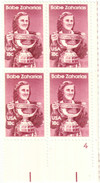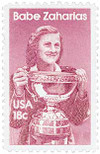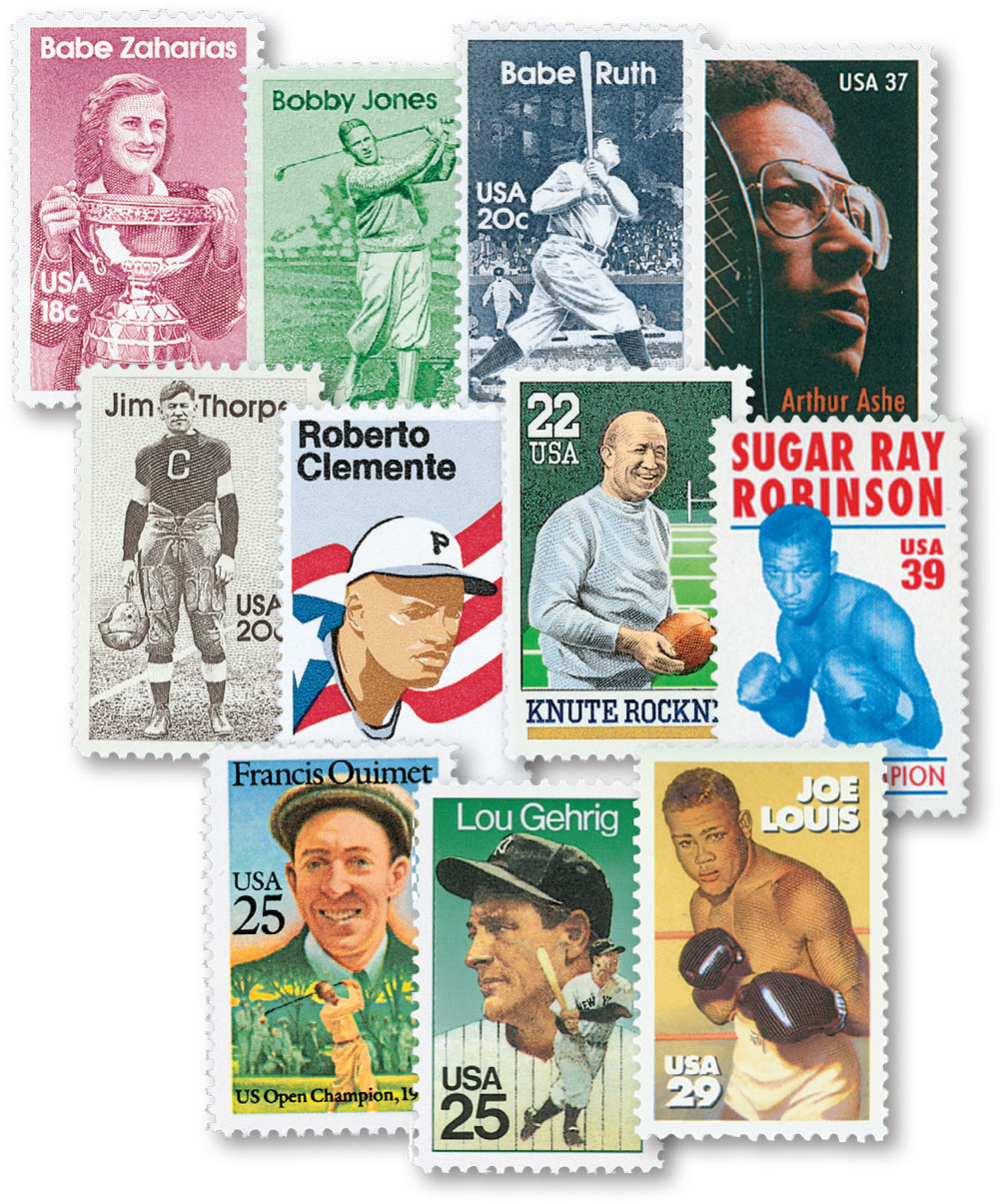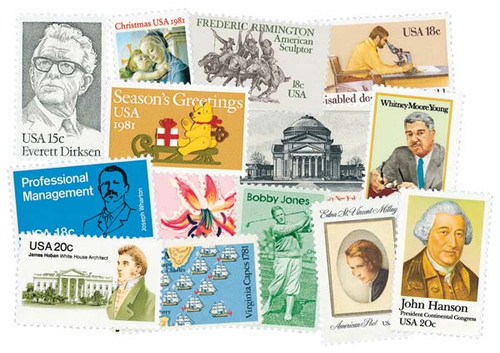
# 1932 - 1981 18c Babe Zaharias
1981 18¢ Babe Zaharias
City: Pinehurst, NC
Quantity: 101,625,000
American Sports Series
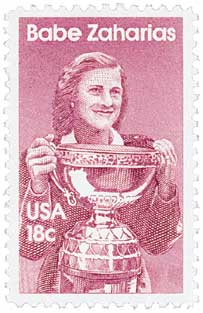
On September 22, 1981, the USPS inaugurated its Sports Series (sometimes called the American Sports Personalities Series), honoring some of America’s most notable athletes.
The first two stamps in the series honored golf legends Babe Zaharias and Bobby Jones and were issued at the World Golf Hall of Fame in Pinehurst, North Carolina.
Babe Zaharias (1911-56) set new Olympic and world records in the javelin throw and won more than 50 major golf tournaments. Zaharias made one of the greatest comebacks in sports history – winning the National Women’s Open and the Tam O’Shanter All-American golf tournaments after major cancer surgery. In 1950, the Associated Press named Zaharias the outstanding woman athlete of the first half of the 20th century.

Bobby Jones (1902-71) is considered one of the greatest American golfers in the history of the sport. He entered his first national golf championship at the age of 14. During his career, Jones won four US Open championships and finished second four more times. He also won three of the four British Open championships in which he competed.

The series continued two years later with the issue of the Babe Ruth stamp on July 6, 1983, marking the 50th anniversary of baseball’s All-Star Game. A special dedication ceremony was held at Chicago’s Comiskey Park during the Old-Timers Game. Babe Ruth (1895-1948) excelled as both a pitcher and a hitter; however, it was as a batter that he achieved his greatest fame. His records include 2,062 career bases on balls and 72 games where he hit two or more home runs. His lifetime batting average was .342. Ruth attracted so many fans to Yankee Stadium, which opened in 1923, that it was nicknamed “The House That Ruth Built.”

Two stamps were issued in 1984. The first honored Jim Thorpe and was issued on May 24 at Shawnee Junior High School, Oklahoma. A versatile athlete who excelled in many sports, Jim Thorpe (1887-1953) became the first athlete to win the pentathlon and decathlon, at the 1912 Summer Olympics. However, he was stripped of his medals when it was learned he had violated Olympic rules by playing semi-pro baseball in 1910. In 1982, the International Olympic Committee reversed its decision and returned the medals to Thorpe’s family.

The series continued on August 17, 1984, with a stamp honoring Roberto Clemente, issued at Clemente’s Sports City for youth in Carolina, Puerto Rico. Clemente helped the Pittsburgh Pirates to their World Series victories in 1960 and 1971. He never went hitless in each of his championship appearances and was named Most Valuable Player of the 1971 World Series. On September 30, 1972, Clemente reached a baseball milestone when he recorded his 3,000th major league hit. Just three months later, on New Year’s Eve, he was killed in an airplane crash while delivering supplies to earthquake-stricken Nicaragua.

The next issue in the series was released on March 9, 1988, and honored Knute Rockne (1888-1931). It was issued in Notre Dame, Indiana, where Rockne served as the football coach for 13 years. Knute Rockne’s football teams won 105 games, lost only 12, and tied 5, giving him a career winning percentage of .881 – the highest in college football history. Rockne served as Notre Dame’s football coach from 1918 until his death in a plane crash. A brilliant strategist, Rockne is credited with helping to popularize the game of football.

The next honoree in the series was golfer Francis Ouimet (1893-1967). His stamp was issued on June 13, 1988, in Brookline, Massachusetts at the Country Club for the 75th anniversary of his victory in the US Open there. Although Ouimet played a key role in popularizing golf, he is relatively unknown to most Americans. As a 20-year-old amateur, he astounded Americans by beating two veteran English professionals at the 1913 US Open Championship. His victory changed the course of golf forever. He is referred to as the “father of amateur golf” in the US and was inducted into the World Golf Hall of Fame in 1974.

Baseball’s “Iron Horse,” Lou Gehrig (1903-41) joined the series on June 10, 1989. His stamp was issued at the National Baseball Hall of Fame in Cooperstown, New York as part of the museum’s 50th anniversary celebrations. Gehrig played an amazing 2,130 consecutive games for the New York Yankees, a record five years longer than that of his nearest rival. When he was finally forced from the line-up, it was due to illness rather than his age.

The next honoree in the series was Joe Louis (1914-81). His stamp was issued at the Joe Louis Arena in Detroit, Michigan for the 55thanniversary of the 1938 match in which he knocked out Max Schmeling in the first round. In 1934, Joe Louis won the National Amateur Association Light Heavyweight Championship and later that year turned to professional boxing. He won his first 23 bouts before being defeated by former heavyweight champion Max Schmeling in 1936. The following year he regained his title, which he successfully defended 25 times until his retirement in 1949. His reign as heavyweight champion, which lasted 12 years, was the longest in the history of the heavyweight division.

The next stamp was issued over a decade later, on August 27, 2005. Honoring tennis great Arthur Ashe, it was issued in Flushing, New York, home of Arthur Ashe Stadium. Ashe (1943-93) broke color barriers in the world of tennis. In 1968, he was the first African-American man to win the US Open. In 1975, Ashe was the first black man to win at Wimbledon. In spite of his outward good health, Ashe was slowed by a 1979 heart surgery and retired in 1980. He underwent a second bypass surgery in 1983, during which he was infected with the HIV virus. When his condition was made public, Ashe founded the Arthur Ashe Institute for Urban Health, prompting Sports Illustrated magazine to name him its Sportsman of the Year.

The final stamp in the series honored boxer Sugar Ray Robinson (1921-89). It was issued on April 7, 2006, in New York, New York. In 1940, after taking the New York Golden Gloves championship, 19-year-old Sugar Ray turned pro. He won his first 40 fights before losing to Jake LaMotta. Robinson did not lose for another eight years. In 1946, he became the welterweight champion. In 1951, he took the middleweight title away from LaMotta. Robinson left the ring in 1952 but returned in 1955. He won and lost the middleweight title three more times before retiring for good in 1965. His record included a 91-fight winning streak. During his professional career, Sugar Ray Robinson had 175 wins, including 109 knockouts.
Click here for more sports stamps.
1981 18¢ Babe Zaharias
City: Pinehurst, NC
Quantity: 101,625,000
American Sports Series

On September 22, 1981, the USPS inaugurated its Sports Series (sometimes called the American Sports Personalities Series), honoring some of America’s most notable athletes.
The first two stamps in the series honored golf legends Babe Zaharias and Bobby Jones and were issued at the World Golf Hall of Fame in Pinehurst, North Carolina.
Babe Zaharias (1911-56) set new Olympic and world records in the javelin throw and won more than 50 major golf tournaments. Zaharias made one of the greatest comebacks in sports history – winning the National Women’s Open and the Tam O’Shanter All-American golf tournaments after major cancer surgery. In 1950, the Associated Press named Zaharias the outstanding woman athlete of the first half of the 20th century.

Bobby Jones (1902-71) is considered one of the greatest American golfers in the history of the sport. He entered his first national golf championship at the age of 14. During his career, Jones won four US Open championships and finished second four more times. He also won three of the four British Open championships in which he competed.

The series continued two years later with the issue of the Babe Ruth stamp on July 6, 1983, marking the 50th anniversary of baseball’s All-Star Game. A special dedication ceremony was held at Chicago’s Comiskey Park during the Old-Timers Game. Babe Ruth (1895-1948) excelled as both a pitcher and a hitter; however, it was as a batter that he achieved his greatest fame. His records include 2,062 career bases on balls and 72 games where he hit two or more home runs. His lifetime batting average was .342. Ruth attracted so many fans to Yankee Stadium, which opened in 1923, that it was nicknamed “The House That Ruth Built.”

Two stamps were issued in 1984. The first honored Jim Thorpe and was issued on May 24 at Shawnee Junior High School, Oklahoma. A versatile athlete who excelled in many sports, Jim Thorpe (1887-1953) became the first athlete to win the pentathlon and decathlon, at the 1912 Summer Olympics. However, he was stripped of his medals when it was learned he had violated Olympic rules by playing semi-pro baseball in 1910. In 1982, the International Olympic Committee reversed its decision and returned the medals to Thorpe’s family.

The series continued on August 17, 1984, with a stamp honoring Roberto Clemente, issued at Clemente’s Sports City for youth in Carolina, Puerto Rico. Clemente helped the Pittsburgh Pirates to their World Series victories in 1960 and 1971. He never went hitless in each of his championship appearances and was named Most Valuable Player of the 1971 World Series. On September 30, 1972, Clemente reached a baseball milestone when he recorded his 3,000th major league hit. Just three months later, on New Year’s Eve, he was killed in an airplane crash while delivering supplies to earthquake-stricken Nicaragua.

The next issue in the series was released on March 9, 1988, and honored Knute Rockne (1888-1931). It was issued in Notre Dame, Indiana, where Rockne served as the football coach for 13 years. Knute Rockne’s football teams won 105 games, lost only 12, and tied 5, giving him a career winning percentage of .881 – the highest in college football history. Rockne served as Notre Dame’s football coach from 1918 until his death in a plane crash. A brilliant strategist, Rockne is credited with helping to popularize the game of football.

The next honoree in the series was golfer Francis Ouimet (1893-1967). His stamp was issued on June 13, 1988, in Brookline, Massachusetts at the Country Club for the 75th anniversary of his victory in the US Open there. Although Ouimet played a key role in popularizing golf, he is relatively unknown to most Americans. As a 20-year-old amateur, he astounded Americans by beating two veteran English professionals at the 1913 US Open Championship. His victory changed the course of golf forever. He is referred to as the “father of amateur golf” in the US and was inducted into the World Golf Hall of Fame in 1974.

Baseball’s “Iron Horse,” Lou Gehrig (1903-41) joined the series on June 10, 1989. His stamp was issued at the National Baseball Hall of Fame in Cooperstown, New York as part of the museum’s 50th anniversary celebrations. Gehrig played an amazing 2,130 consecutive games for the New York Yankees, a record five years longer than that of his nearest rival. When he was finally forced from the line-up, it was due to illness rather than his age.

The next honoree in the series was Joe Louis (1914-81). His stamp was issued at the Joe Louis Arena in Detroit, Michigan for the 55thanniversary of the 1938 match in which he knocked out Max Schmeling in the first round. In 1934, Joe Louis won the National Amateur Association Light Heavyweight Championship and later that year turned to professional boxing. He won his first 23 bouts before being defeated by former heavyweight champion Max Schmeling in 1936. The following year he regained his title, which he successfully defended 25 times until his retirement in 1949. His reign as heavyweight champion, which lasted 12 years, was the longest in the history of the heavyweight division.

The next stamp was issued over a decade later, on August 27, 2005. Honoring tennis great Arthur Ashe, it was issued in Flushing, New York, home of Arthur Ashe Stadium. Ashe (1943-93) broke color barriers in the world of tennis. In 1968, he was the first African-American man to win the US Open. In 1975, Ashe was the first black man to win at Wimbledon. In spite of his outward good health, Ashe was slowed by a 1979 heart surgery and retired in 1980. He underwent a second bypass surgery in 1983, during which he was infected with the HIV virus. When his condition was made public, Ashe founded the Arthur Ashe Institute for Urban Health, prompting Sports Illustrated magazine to name him its Sportsman of the Year.

The final stamp in the series honored boxer Sugar Ray Robinson (1921-89). It was issued on April 7, 2006, in New York, New York. In 1940, after taking the New York Golden Gloves championship, 19-year-old Sugar Ray turned pro. He won his first 40 fights before losing to Jake LaMotta. Robinson did not lose for another eight years. In 1946, he became the welterweight champion. In 1951, he took the middleweight title away from LaMotta. Robinson left the ring in 1952 but returned in 1955. He won and lost the middleweight title three more times before retiring for good in 1965. His record included a 91-fight winning streak. During his professional career, Sugar Ray Robinson had 175 wins, including 109 knockouts.
Click here for more sports stamps.







